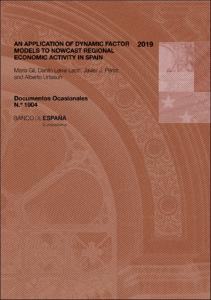An application of dynamic factor models to nowcast regional economic activity in Spain
Authors
Issue Date
7-Mar-2019
Physical description
27 p.
Abstract
El objetivo de este trabajo es el desarrollo de modelos de factores dinámicos para generar estimaciones de crecimiento del PIB a corto plazo (nowcast) a escala regional. El uso de esta metodología permite incorporar, de una manera parsimoniosa, la información relevante disponible en el momento de realizar las estimaciones. Se utiliza una perspectiva bayesiana para conseguir estimaciones robustas de todos los ingredientes del modelo. Así, se introduce el modelo de factores bayesiano para las regiones (BayFaR, denominación en inglés), que permite incluir indicadores con observaciones no disponibles, así como combinar distintas frecuencias: tasas de crecimiento del PIB para las diferentes regiones en frecuencia trimestral (obtenidas tanto de AIReF como de los institutos de estadística regionales) e información mensual procedente de los indicadores de actividad regional. Aplicamos el modelo de factores bayesiano con el propósito de obtener estimaciones de crecimiento del PIB a corto plazo para las cuatro mayores regiones de España, y se ilustra la evolución de las estimaciones en tiempo real en cada uno de los casos. También se aplica el mismo modelo para realizar el nowcast del PIB del conjunto de la economía a fin de poder valorar la evolución relativa de cada una de las regiones
The goal of this paper is to propose a model to produce nowcasts of GDP growth of Spanish regions, by means of dynamic factor models. This framework is capable to incorporate in a parsimonious way the relevant information available at the time that each forecast is made. We employ a Bayesian perspective to provide robust estimation of all the ingredients involved in the model. Accordingly, we introduce the Bayesian Factor model for Regions (BayFaR), which allows for the inclusion of missing data and combines quarterly data on regional real output growth (taken from the database of the AIReF and from the individual regional statistics institutes, when available) and monthly information associated to indicators of regional real activity. We apply the BayFaR to nowcast the GDP growth of the four largest regions of Spain, and illustrate the real-time nowcasting performance of the proposed framework for each case. We also apply the model to nowcast Spanish GDP in order to be able to assess the relative growth of each region
The goal of this paper is to propose a model to produce nowcasts of GDP growth of Spanish regions, by means of dynamic factor models. This framework is capable to incorporate in a parsimonious way the relevant information available at the time that each forecast is made. We employ a Bayesian perspective to provide robust estimation of all the ingredients involved in the model. Accordingly, we introduce the Bayesian Factor model for Regions (BayFaR), which allows for the inclusion of missing data and combines quarterly data on regional real output growth (taken from the database of the AIReF and from the individual regional statistics institutes, when available) and monthly information associated to indicators of regional real activity. We apply the BayFaR to nowcast the GDP growth of the four largest regions of Spain, and illustrate the real-time nowcasting performance of the proposed framework for each case. We also apply the model to nowcast Spanish GDP in order to be able to assess the relative growth of each region
Publish on
Documentos Ocasionales / Banco de España, 1904
Subjects
Actividad regional; Nowcasting; Modelo de factores dinámicos; Regional activity; Dynamic factor model; Fluctuaciones y ciclos económicos; Economía regional y recursos naturales; Modelos econométricos; España
Appears in Collections:












